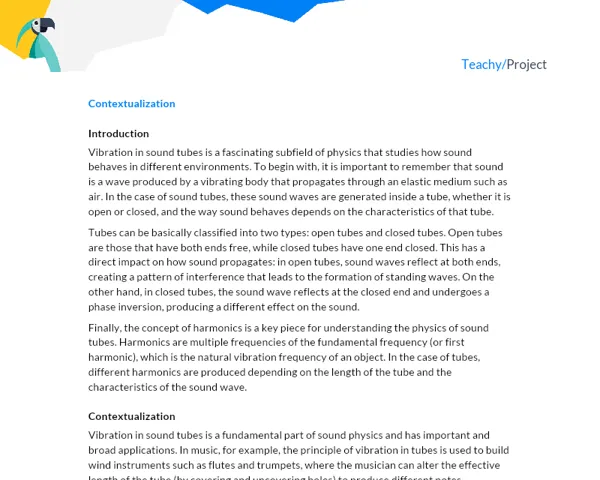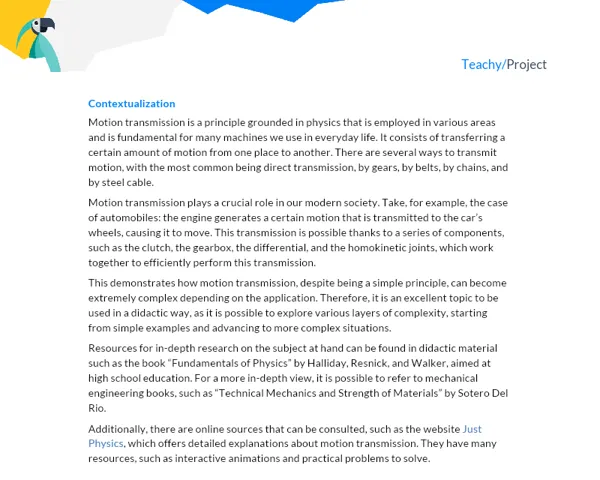Context
Mechanical energy and Simple Harmonic Motion (SHM) are two fundamental concepts that allow us to understand a variety of physical phenomena in our daily lives. Mechanical energy, which is the sum of kinetic and potential energies in a given system, is a fundamental pillar in the analysis of physical systems. It allows us to understand, for example, how an object thrown into the air returns to the ground or how a pendulum swings from side to side.
Simple Harmonic Motion (SHM) is a particular type of oscillation that occurs when the restoring force is directly proportional to the displacement, but in the opposite direction. Many physical systems, when perturbed, oscillate about a stable equilibrium point. Some examples of this include an object hanging from a spring, a swinging pendulum, an LC oscillator in electronics, among others.
When we combine these two concepts, we can analyze situations where there is a continuous conversion between kinetic energy and potential energy. In SHM, there are moments when all the energy of the system is in the form of potential energy (at the extreme points of the movement) and moments when all the energy is in the form of kinetic energy (at the middle points of the movement).
These concepts are of vital importance for a number of real-world applications. They are the basis for understanding how bridges, buildings, and other structures oscillate when disturbed by external forces (such as wind or earthquakes); in mechanical engineering, in the analysis of machines that make periodic movements; in quantum physics, to understand the energy stored in an atom, and even in biology, to understand how energy waves pass through biological tissues.
Below, we suggest some resources that can help you to delve deeper into the subject:
- Simple Harmonic Motion - Encyclopedia Britannica
- Mechanical Energy - Science Direct
- Video - Simple Harmonic Motion - The Physics Classroom
- Video - Mechanical Energy in SHM - Khan Academy
- Book: "Fundamentals of Physics. Gravitation, Waves, and Thermodynamics", David Halliday, Jearl Walker, Robert Resnick
Hands-on Activity
Activity Title: Study of Simple Harmonic Motion in a Mechanical System
Project Objective:
This project aims to provide a practical and empirical experience of the concepts of Simple Harmonic Motion (SHM) and the conservation of mechanical energy in a simple spring-mass system.
Detailed Project Description:
Student groups will build and test a spring-mass system, observing the characteristics of Simple Harmonic Motion and the principle of conservation of mechanical energy. The students will investigate how the energy in an oscillating system is transferred between the elastic potential energy of the spring and the kinetic energy of the oscillating object.
Materials Required:
- A spring
- An object of known mass that can be attached to the spring (a small weight or building blocks work well)
- A ruler or measuring tape to measure the elongation/recoil of the spring
- A camera or smartphone to film the experiment and analyze the motion.
- Free video analysis software (e.g., 'Tracker' or similar apps) for data extraction from the video.
Detailed step-by-step procedure for carrying out the activity:
-
Securely fasten the spring to a high point where the object will be able to oscillate up and down without obstruction.
-
Attach the object of known mass to the end of the spring.
-
With the ruler or measuring tape, measure the equilibrium position of the object (the position at which the object rests when it is not disturbed).
-
Stretch the spring from the equilibrium position and release it, initiating the oscillatory motion. Make sure to film the motion throughout its course.
-
Use the video analysis software to track the position of the object at each instant and generate a graph of position versus time for the motion.
-
Analyze the obtained graph: it should be a sinusoid, characteristic of Simple Harmonic Motion.
-
Using the software's analysis tools, determine the frequency and period of the motion.
-
Based on the collected data and the learned theoretical knowledge, discuss how energy is transferred between kinetic energy and elastic potential energy, and how this is manifested in the observed motion.
Project Deliverables:
OThe final deliverable should include a video of the experiment, graphs of position versus time, and a detailed report that includes:
-
Introduction: Present the context of the experiment, the theory of Simple Harmonic Motion and Mechanical Energy, the motivation for the project, and what you expect to learn from it.
-
Development: Describe in detail the experiment carried out, including how it was set up, the data collected, and the analysis done. Include graphs and tables as appropriate to illustrate the results. Explain how the observed motion demonstrates the conservation of mechanical energy.
-
Conclusions: Discuss what was learned from the experiment, what were the difficulties faced and overcome, and how the hands-on experience helped to understand the concepts of Simple Harmonic Motion and Mechanical Energy.
-
Bibliography: List all the sources of information used during the project.
Remember, the objective of this project is for you to work as a team, learn to manage time, and develop problem-solving and critical thinking skills. Good luck and have fun with the experience!



